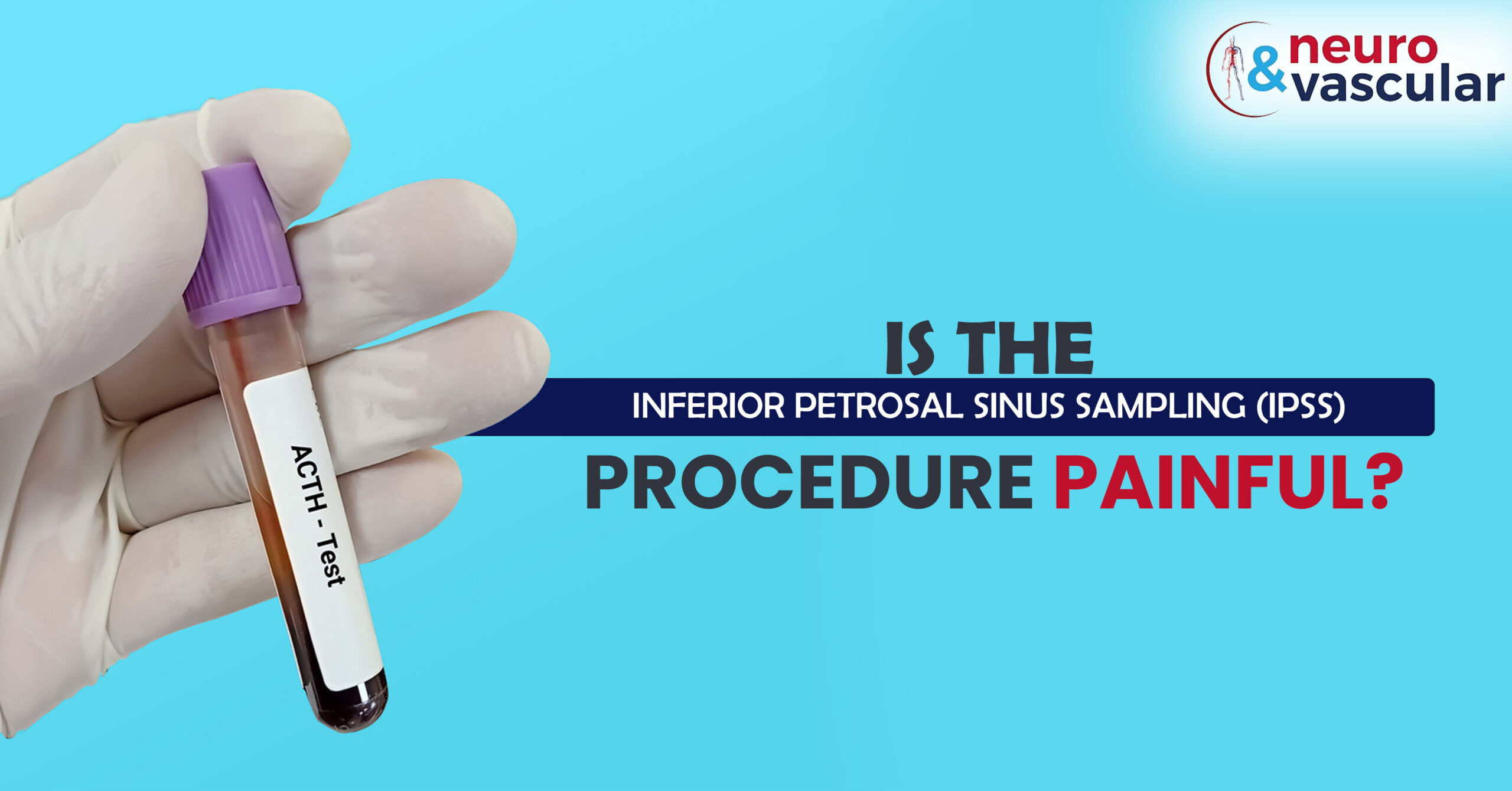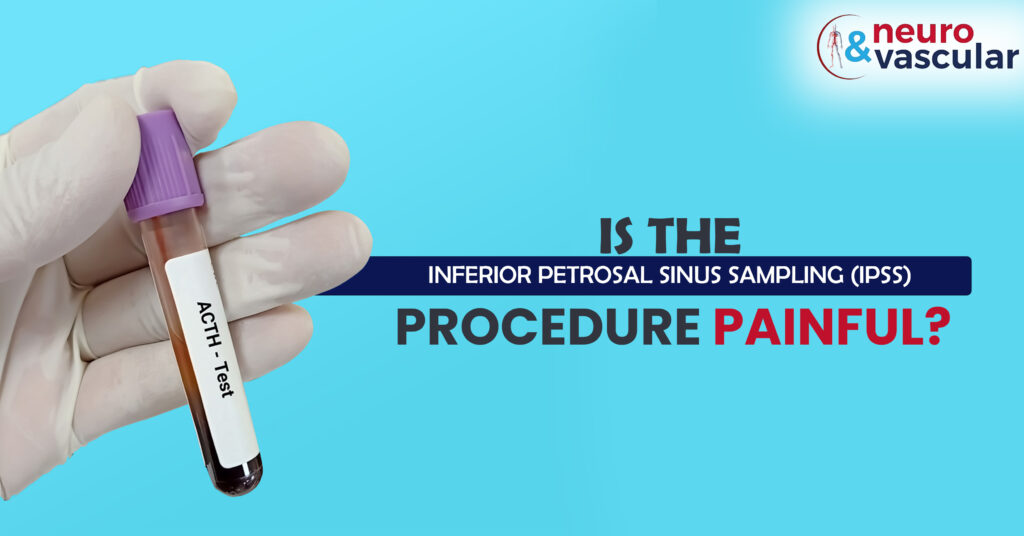
Is the Inferior Petrosal Sinus Sampling (IPSS) procedure Painful?

IPSS is a minimally-invasive neuro-interventional procedure performed to sample venous blood from the pituitary gland. Inferior petrosal sinus sampling (IPSS) procedure in which adrenocorticotropic hormone (ACTH) levels are sampled from veins draining the pituitary gland and compared to ACTH levels in peripheral blood to determine whether a (rather than an ectopic source of ACTH) is responsible for ACTH-dependent Cushing syndrome. The IPSS can also determine which side of the pituitary gland the tumor is on. Inferior petrosal sinus sampling (IPSS) is used to aid in the diagnosis of Cushing’s disease.
What is Cushing’s syndrome and Disease?
Cushing’s syndrome is caused by an excessive amount of the hormone cortisol. It is normally produced by the adrenal gland and can cause a myriad of symptoms when in excess. The cause can be an adrenal gland tumor or tumor either in the pituitary gland or elsewhere, that causes the adrenal gland to produce excess cortisol. Cushing’s disease occurs when the tumor is in the pituitary gland, which excessively produces an adrenocorticotrophic hormone, which in turn causes the adrenal gland to produce excessive cortisol. The IPSS test is used in some patients to determine whether too much ACTH is causing excessive cortisol production and to know its source
What are the signs and symptoms of Cushing’s disease?
- Gaining weight
- Thin arms and legs.
- A round face.
- The fat build-up at the base of the neck
- A fatty hump between the shoulders.
- Easy bruising
- Wide purple stretch marks on the abdomen, breasts, hips, and underarms.
- Muscle weakness
- Hypertension
What tests will be done to diagnose Cushing’s syndrome?
- A 24-hour urinary cortisol test
- Midnight salivary cortisol test
- Low-dose dexamethasone suppression test
- Blood test
- High-dose dexamethasone suppression test
- CT scan or MRI scan of the abdomen
In some cases, MRI fails to identify an abnormality. If your Interventional neuro radiologist suspects Cushing’s disease, he or she may order super-selective inferior petrosal sinus sampling (IPSS).
IPSS must be performed by an experienced interventional neuroradiologist because it carries risk, and if done inappropriately, can give misleading results.
How Is Inferior Petrosal Sinus Sampling Performed?
It is done under local anesthesia. Typically the performing doctor inserts small tubes (catheters) into the femoral veins (the main vein draining the legs) at the groin level. The catheters are then guided to the main veins that drain the Pituitary gland using X-ray guidance. These are known as the inferior petrosal sinuses (right and left). Then the doctor takes blood samples from those veins as well as the main vein in the abdomen and tests them for ACTH. The doctor also collects timed samples after administering a medication that would normally stimulate ACTH production in order to improve the test’s sensitivity.
When we receive the results, the different levels of ACTH may aid in determining the location of the tumor that is causing the adrenal gland to produce excessive cortisol. If it is from the pituitary gland, any difference between the right and left samples may aid the surgeon in devising a surgical strategy to remove the tumour while preserving the normal Pituitary gland.
What to expect during the procedure:
- Patients must lie flat on a specialized X-ray table.
- To numb the groin area, a local anesthetic injection is injected.
- As catheters are inserted into the main vein in each groin, patients will feel some gentle pushing.
- The catheters are then guided up into the vein near the pituitary gland. This manoeuvre is generally painless.
- X-rays are taken to ensure that the catheters are being guided to the proper location.
- A series of blood samples are collected over a 10-minute period.
- A hormone called CRH will be injected through one of the catheters, which may cause a brief “flushing” sensation.
- Once blood samples are taken, the catheters are removed.
- Patients are asked to lie flat for about 30 minutes before being returned to the recovery area and gradually allowed to sit up in bed.
- After a period of observation, patients are allowed to go home.
Contraindications to IPSS:
Contraindications to IPSS include the following:
- Bleeding diathesis or disorders
- Allergies to dye contrast
- Orthopnoea
Complications of IPSS:
Complications are infrequent, seen in less than 1% of cases, and include:
- Deep cerebral venous thrombosis
- Pulmonary embolism
- Venous subarachnoid hemorrhage (SAH)
- Brain stem ischemic injury
Conclusion:
IPSS was a safe and well-tolerated procedure. It is effective in the diagnosis of ACTH-dependent Cushing’s syndrome (CS) and useful in planning Cushing’s disease (CD) surgical therapy.
Frequently Asked Questions:
Q: How long does an IPSS test take?
A: Total procedure duration is approximately about 30-45 minutes
Q: Is petrosal sinus sampling painful?
A: Petrosal sinus sampling is an invasive procedure that involves taking blood samples from both sides of the veins that drain into the pituitary gland. Although the procedure is not painful, you may feel minor discomfort in the groin, as the catheter (tubing) is passed through your veins.
Q: Is inferior petrosal sinus sampling safe?
A: Inferior petrosal sinus sampling (IPSS) is an effective diagnostic method for adrenocorticotropic hormone (ACTH)-dependent hypercortisolism with normal or equivocal MR imaging. The procedure is believed to be safe and well-tolerated.
About the Author:

Name: DR . SURESH GIRAGANI
INTERVENTIONAL RADIOLOGIST
DR. SURESH GIRAGANI CONSULTANT INTERVENTIONAL RADIOLOGIST at Apollo hospitals Jubilee Hills, has more than sixteen years of clinical experience in vascular interventions with a special interest in neurovascular and peripheral vascular disease interventional procedures.